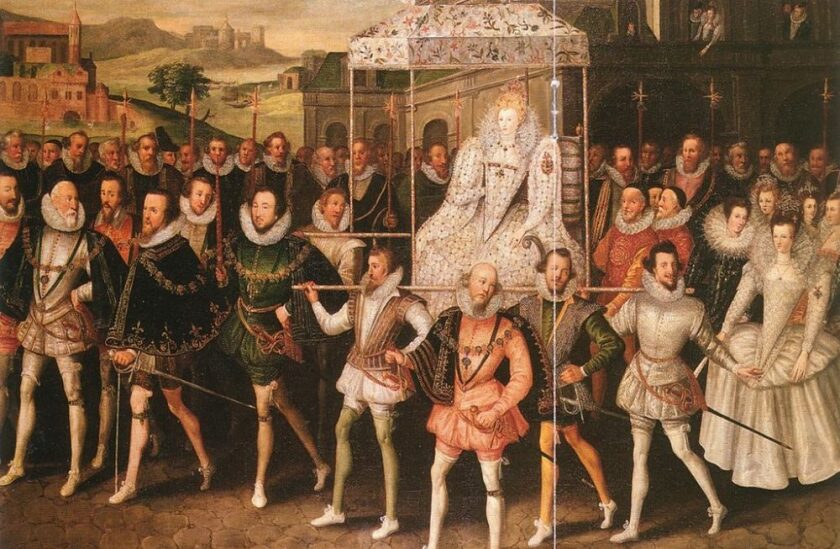
I know I have but the body of a weak and feeble woman, but I have the heart and stomach of a king, and of a king of England too.
– Queen Elizabeth I
The Elizabethan Era, the period in which Julius Caesar was written, was a flowering of culture, a long span of relative peace and prosperity in British history during the remarkably long reign of Elizabeth I. Particularly, given the turbulence of the periods immediately before and after her reign, the “golden age” of British history, as it is sometimes called, saw great achievements in the arts, poetry, language, music, and theatre.

The reign of Queen Elizabeth is often referred to as the “golden age” due to Elizabeth’s efforts to encourage peace and unity among her subjects. When Elizabeth became queen, people hoped that would lead to more religious toleration. The religion shifted from her sister Mary’s Catholicism back to the Church of England where the English monarch is the head of the Church. Queen Elizabeth I was raised Protestant and ruled as such with efforts in trying to convert the country. This was a drastic change as her predecessor, Queen Mary, attempted to eliminate Protestantism from England completely. Regardless of her being Protestant, Queen Elizabeth declared that as long as people were obedient to her, she would “tolerate all but the most radical sects.”
Power in Elizabethan England was mainly in the hands of the monarch. Political power was held in the Court where wealthy citizens went and attempted to win the favor of the Queen. Unlike today, the Parliament in Elizabethan England had less authority and met less frequently. Instead, the Privy Council (composed of men from the nobles, gentry, and the Church), was more prominent and worked to advise the Queen and act as her ministers.
Queen Elizabeth never married during her rule. This created multiple issues namely that of succession and having a female ruler. If she were married, they would have felt more secure about having a woman on the throne and potentially having a continued, direct line of succession. Queen Elizabeth remained unmarried and died without an heir. The dynasty would come to an end and she would be succeeded by the protestant James VI of Scotland, the son of her cousin Mary, Queen of Scots.
Typical of the time, the rights women had were very few. Women essentially belonged to their fathers and then to their husbands when they married. The legal age for a woman to marry in the Elizabethan Era was twelve years old. Women were seen as inferior to men in this patriarchal society, despite having an unmarried woman on the throne. They were seen as the weaker sex, physically and emotionally, and were only allowed to receive an education through private tutors in their homes. The only occupation they could take part in were domestic fields such as cooking, cleaning, and writing.
Shakespeare was one of the most prominent figures of the theatre scene and the Elizabethan era. He owned the Globe Theatre and went on to write at least thirty-seven plays in his lifetime. Many have the opinion that Julius Caesar was the first play performed in the Globe Theatre, but it can’t be certain. While Queen Elizabeth I was supportive of Shakespeare, she was not a Royal patron of his. She, in fact, had her own theatre which gained popularity in the late 16th century. An aspect of the play which parallels the social structure of the time was the role of the Plebeians. The behavior of plebeians was so changeable based on the opinions of the leaders in the play, but their support and contribution to society were still largely significant. This could be directed toward the lower-class citizens (who were allowed to watch the show in an area where there was no cover if the weather was bad) who were mistreated and at a disadvantage in society, but altogether still a part of society.
Another aspect of the Elizabethan era was exploration and circumnavigation. Queen Elizabeth furthered the establishment of the First British Empire by granting a patent for exploration in the Americas to Humphrey Gilbert and Walter Raleigh. She then granted a charter to the East India Company in 1600. She also established a strong royal navy. Queen Elizabeth’s predecessors, King Edward VI and Queen Mary I, did little with the Royal Navy. But Queen Elizabeth used it to her benefit and made it a priority. For over twenty years there was continuous progress made on the naval fleet. By the time of the invasion of the Spanish Armada, there were thirty-four ships available in the Navy. Philip II of Spain launched an invasion of England to remove Elizabeth and restore Catholicism, but the Spanish Armada was severely defeated by the English Navy.
Queen Elizabeth I was one of the most influential rulers of the Tudor-Stuart period, and perhaps one of the most influential women in history. Not only did she rule without the influence of a king or husband, but she ruled powerfully and arguably better than any predecessor. She proved that women were not the weaker sex, but were just as capable of social and military success as her male counterparts. She built and maintained a strong navy, promoted the arts, and established a society of greater religious toleration propelling her people into the new modern world.


